8 Vegetables That You Can Regrow Again And Again.
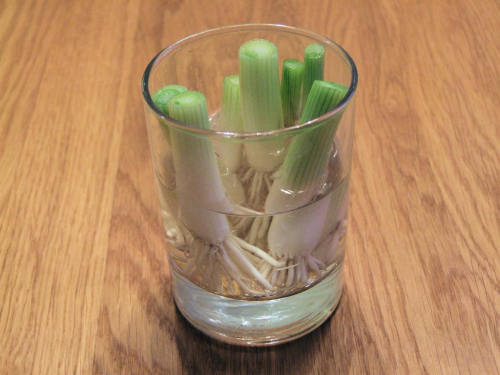
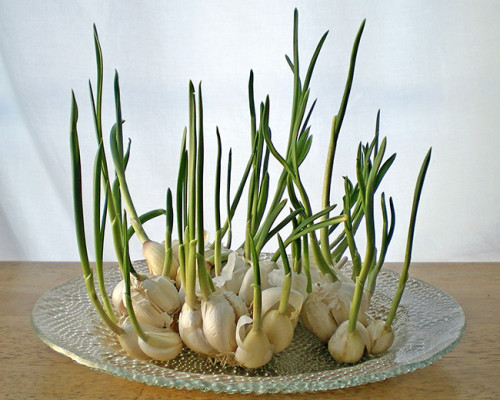
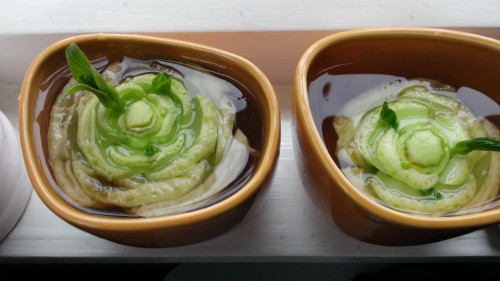
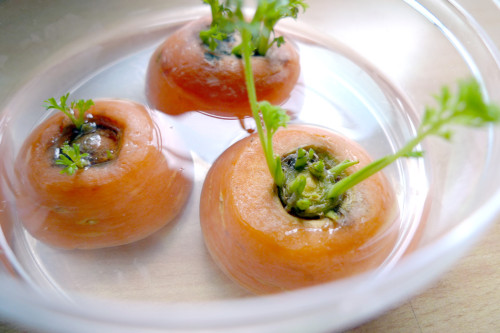
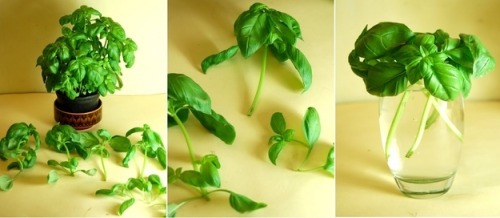

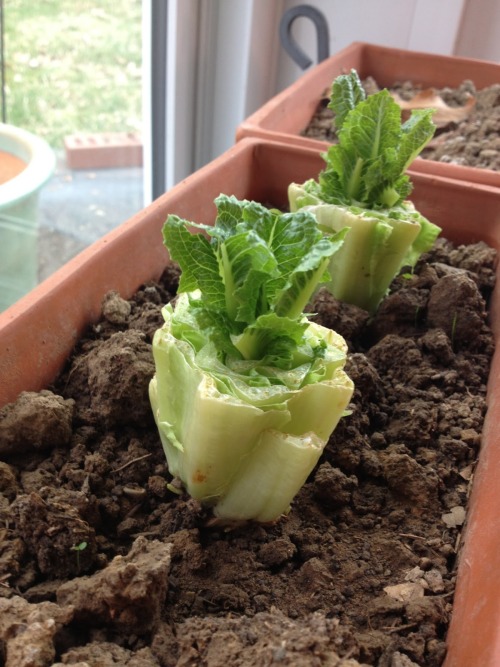
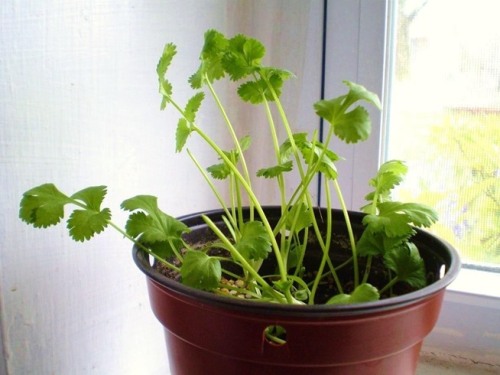
8 vegetables that you can regrow again and again.
Scallions
You can regrow scallions by leaving an inch attached to the roots and place them in a small glass with a little water in a well-lit room.
Garlic
When garlic begins to sprout, you can put them in a glass with a little water and grow garlic sprouts. The sprouts have a mild flavor than garlic and can be added to salads, pasta and other dishes.
Bok Choy
Bok choy can be regrown by placing the root end in water in a well-lit area. In 1-2 weeks , you can transplant it to a pot with soil and grow a full new head.
Carrots
Put carrot tops in a dish with a little water. Set the dish in a well-lit room or a window sill. You’ll have carrot tops to use in salads.
Basil
Put clippings from basil with 3 to 4-inch stems in a glass of water and place it in direct sunlight. When the roots are about 2 inches long, plant them in pots to and in time it will grow a full basil plant.
Celery
Cut off the base of the celery and place it in a saucer or shallow bowl of warm water in the sun. Leaves will begin to thicken and grow in the middle of the base, then transfer the celery to soil.
Romaine Lettuce
Put romaine lettuce stumps in a ½ inch of water. Re-water to keep water level at ½ inch. After a few days, roots and new leaves will appear and you can transplant it into soil.
Cilantro
The stems of cilantro will grown when placed in a glass of water. Once the roots are long enough, plant them in a pot in a well-lit room. You will have a full plant in a few months.
More Posts from Green-notebooks and Others

What is the value of a street where people can walk safely? Why build streets that are constructed with the needs of people in mind, not just the needs of cars?
“Again and again, when we look at streets oriented toward people we find that they are more economically productive than any other style of development.”
Many people concerned with pedestrian safety and “walkability” care about these issues because they feel that walking is good exercise or that walkable places are more attractive or that walking is better for the environment than driving.
These are all valid arguments and may convince some of those reading this article that walkability is important. But what I want to talk about today isn’t an argument based on values or aesthetics. It’s an argument based on pure dollars and cents — one that should convince people with a myriad of values and political leanings that people-oriented places must be a priority if we want our communities to be economically prosperous.
Again and again, when we look at streets oriented toward people — that is, streets where walking is safe and enjoyable, that people are drawn to visit on foot, and where fast and extensive car traffic is not the #1 priority — we find that they are more economically productive than any other style of development. This is particularly true when we compare people-oriented places to car-oriented places—think of that stretch of your town that effectively does everything possible to discourage walking and biking, including a street with multiple wide lanes to ensure fast car movement, acres of parking, and minimal (if any) sidewalks, bike lanes and crosswalks.
Walkable streets, on the other hand, encourage business activity, generate greater tax revenue per acre and offer a higher return on investment than auto-oriented streets.

Earth is truly healing



But none of the challenges posed by our warming climate has loomed larger in the popular imagination than sea-level rise. With global populations and wealth heavily concentrated in low-lying coastal cities, humanity has been preoccupied by the prospect of the oceans reclaiming the high points of our civilization. And for good reason: The best available models suggest that 37 million people currently live in places that will be below high tide by 2050 — in an optimistic low-carbon-emissions scenario.
Or rather, that’s what such models suggested before this week. On Tuesday, a new study revealed that those alarming statistics — which had gotten so many of us all worked up about our favorite cities’ impending doom — were wildly inaccurate.
The actual impacts of sea-level rise are going to be much, much worse.
Listen, folks, few understand the enormity of what is happening, nor how fast it’s occurring, and, look, I don’t count myself among those few.
The rest of us do not realize the catastrophe that is happening right now.
Maybe that’s not fair to say: the people of California probably understand all too well. Even if their home is not on fire, certainly they see the hellish red glow in the sky and cannot avoid the acrid smell of wildfire smoke.
For sure, the indigenous folk who subsist on whale meat understand the crisis, since the bowheads they hunt have not appeared. None of them. They are way out to sea, trying to avoid the warming oceans and underwater heat waves.
The people of Key West, who have endured a “king tide” flooding their city streets for 60+ days straight, probably think there’s a big problem. Some of them, no doubt, are hanging on to the foolish belief that this tide is going to subside – it’s not – it’s rapid sea level rise.
It’s not our fault though, that we do not know … did not know, because, everything we have been told, the stuff that has made it out of the media in the past decade or so, has all been based on these same “optimistic low-carbon-emissions scenarios.”
This is not the world we live in. We live in the high-emission catastrophic scenario. We were shown these, when we were shown anything at all, but we were told these catastrophic emission scenarios would never, ever – couldn’t possibly – ever be so.
Yeah, well, we were wrong about.
But seriously, when we got our property, it was all just…grass. A sterile grass moonscape, like a billion other yards. With two big old maple trees. Just grass and maples, that was it.
But then I got my grubby little paws on it, and I immediately stopped fertilizing, spraying, and bagging up grass clippings and leaves. I ripped up sod and put in flowers and vegetables. I put down nice thick blankets of mulch around the flowers and vegetables.
When I first was sweating my way through stripping sod, I saw a grand total of 1 worm and 0 ladybugs. The ground was compacted into something that would bend shovel blades.
Now, six years later, I can’t dig a planting hole without turning up fourteen earthworms, and there are so many ladybugs here. Not the invasive asian lady beetles; native ladybugs. They winter over in the mulch and in the brush pile. I see thousands of them.
The soil is soft and rich. There are birds that come to eat, and bees of many sorts.
Like this is something that you, yourself, can absolutely change. This is something that you, personally, can make a difference in.
Learning about edible plants (and eating them) has given me a lot of insight into the problems with the USAmerican food system
It's incredible how a supermarket gives you the sense of being surrounded by immense variety, but it's just the visual noise of advertising. In reality almost everything around you is just corn, wheat, soy, and milk, repackaged and recombined and concealed and re-flavored using additives, over and over and over again.
if you’re interested in mutual aid and aren’t sure where to start, i can’t recommend enough joining a local Buy Nothing group. in a nutshell, it’s a totally free gift economy— people give from their own abundance and ask for what they need. it’s indispensable as a recent grad household— we got the majority of our basic furniture, as well as an AC unit through the group— but what i find particularly wonderful are the ways other forms of community aid popup through the group.
i’ve seen people organize meal trains for strangers. people fleeing from domestic violence have gone from a suitcase of possessions to a fully stocked house in 48 hours. home hospices being set up with goods from six different households. cookbook lending. distribution of windfall apples and tomato harvest overabundance. grocery pickup for ill folks. people looking out for listings for others. everything from bread to baby carseats to house paint to pet food.
and much of it is done between strangers, often between people who would not recognize or identify with the term “mutual aid”. it lowers waste, goods go directly to people who need them, and it avoids the sometimes dubious morality of the thrift shop circuit. i’d really recommend it.
A brief and ugly summary of surviving cold climates
For visitors and writers alike.
You were never meant to be here. Never forget this. You are an ape of the equator, built to run the savannah and swim in tropical waters. Whatever terms and conditions your body has, they are void here. Mother nature never certified to function in a Death World.
Enduring the cold is never a matter of “how much” as much at it is “how long”. Think of it as the water levels of the vieogames you have played. No matter what equipment enables you to remain longer, you can’t stay there indefinitely. The coat that keeps you warm and toasty for three hours in -15 is enough to keep you functional for an hour of -40.
Whatever the locals say, listen to them. Err to the side of caution if you must. You may not endure what they can endure, but you SURE AS FUCKING NOT cannot survive what they say cannot be endured.
That being said, alcohol is a filthy fucking liar and so is anyone who offers it to you. The warmth it gives is an illusion, and a sign of damage. You are worse off feeling comfortable with a mouthful of whiskey as you are freezing your gonads off stone cold sober.
Winter tires. Studded winter tiers are a MATTER OF LIFE AND DEATH when you drive on a frozen road. That being said, whatever the locals tell you that your car will need to run as theirs do, take it. Taking the risk of being pranked is worth survival, and you can always stab their tires in the spring if they were shitting you.
Eat. For the love of god, make sure that you eat. Heavier meals might be unpalatable at first for someone used to lighter nutrition, but maintaining bodily warmth in a cold climate takes up a lot of energy, and you will feel tired and drowsy for a long while shile your metabolism adjusts to producing more heat than Mother Nature ever intended. The skinny people in your party are especially vulnerable, ensure their well-being on a regular basis.
If you have a smartphone/other essential technology on your body, keep them close to your body to keep them warm. They were not designed to be frozen any more than you were.
Sleep is death. SLEEP IS DEATH. Never, ever stop to rest in the cold, if you do not have the means to make a fire/otherwise produce heat. The cold tires you out because keeping warm takes energy, but taking a rest will not return your energy. If you feel the need to sit down and rest because you are tired because of the cold, call for help. This is not a hyperbole, if you feel like you are too tired to go on in a cold climate, CALL A FUCKING AMBULANCE. If you fall asleep in the snow, you will not wake up. Hypothermia can and will literally kill you.
Avoid skin-to-snow-contact if you can. It hurts because you were not supposed to do it. Consider ice to be like acid. Touching is bad for you.
Feel free to add to the list if you feel like I missed something.





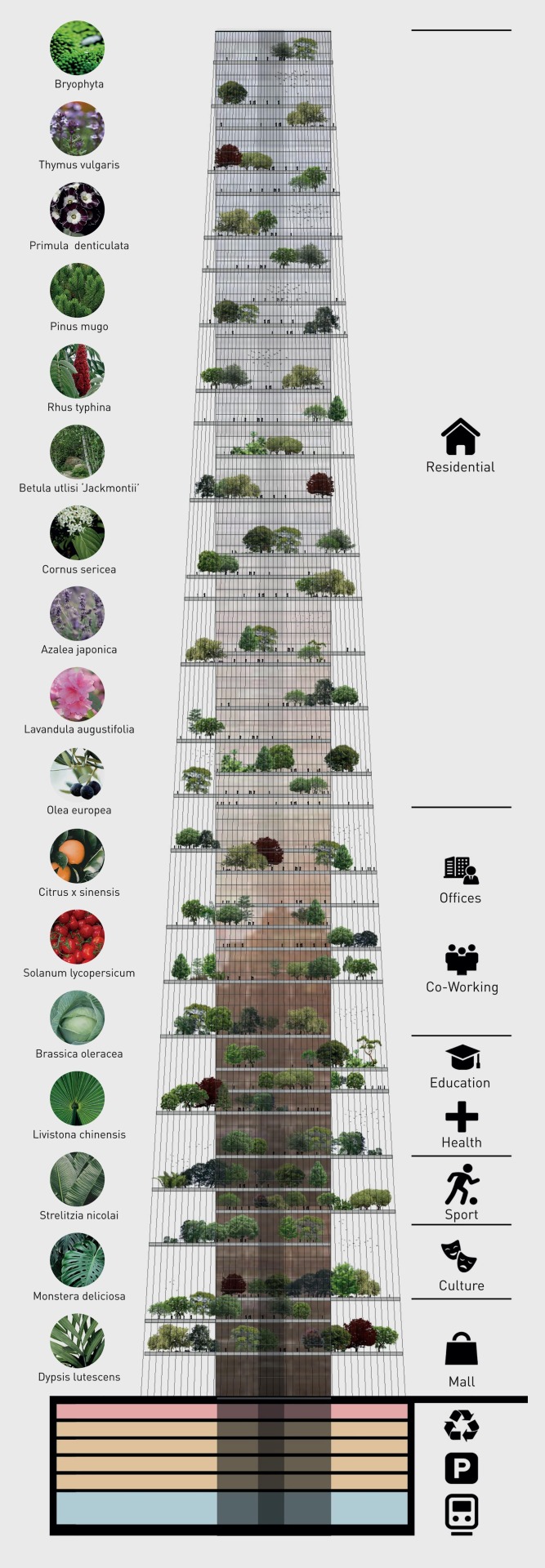



‘Skylines,’ New York, United States,
Lissoni Casal Ribeiro for Skyhive 2020 skycraper Challenge
Inspired by nature, the concept proposes a complete, self-sufficient ecosystem. the multi-use tower collects rainwater and gathers energy from the sun and the wind, transforming it from its tensioned cables into electricity to be used by inhabitants.
-
 joliebiijou reblogged this · 2 weeks ago
joliebiijou reblogged this · 2 weeks ago -
 7---freya---7 reblogged this · 2 weeks ago
7---freya---7 reblogged this · 2 weeks ago -
 vvermell reblogged this · 3 weeks ago
vvermell reblogged this · 3 weeks ago -
 dannyboyrope reblogged this · 3 weeks ago
dannyboyrope reblogged this · 3 weeks ago -
 yourwaitressismiserable reblogged this · 3 weeks ago
yourwaitressismiserable reblogged this · 3 weeks ago -
 mjimen19 liked this · 3 weeks ago
mjimen19 liked this · 3 weeks ago -
 blissfulamiwonderland liked this · 1 month ago
blissfulamiwonderland liked this · 1 month ago -
 sweettartcookies reblogged this · 1 month ago
sweettartcookies reblogged this · 1 month ago -
 sweettartcookies liked this · 1 month ago
sweettartcookies liked this · 1 month ago -
 hewwodarkness liked this · 1 month ago
hewwodarkness liked this · 1 month ago -
 losingtrackoftimeandspace liked this · 1 month ago
losingtrackoftimeandspace liked this · 1 month ago -
 idontknow13538 liked this · 1 month ago
idontknow13538 liked this · 1 month ago -
 5150 liked this · 2 months ago
5150 liked this · 2 months ago -
 jadedhawk liked this · 2 months ago
jadedhawk liked this · 2 months ago -
 dawn-of-the-fairies reblogged this · 2 months ago
dawn-of-the-fairies reblogged this · 2 months ago -
 millenniumtrampstamp liked this · 2 months ago
millenniumtrampstamp liked this · 2 months ago -
 cyborgmagm4r reblogged this · 2 months ago
cyborgmagm4r reblogged this · 2 months ago -
 tv-ajax liked this · 2 months ago
tv-ajax liked this · 2 months ago -
 papermachetincan liked this · 2 months ago
papermachetincan liked this · 2 months ago -
 dmcofficial reblogged this · 3 months ago
dmcofficial reblogged this · 3 months ago -
 darkestskull liked this · 3 months ago
darkestskull liked this · 3 months ago -
 ellensilica liked this · 3 months ago
ellensilica liked this · 3 months ago -
 sunslept liked this · 3 months ago
sunslept liked this · 3 months ago -
 alternativerabbit reblogged this · 3 months ago
alternativerabbit reblogged this · 3 months ago -
 husgroda reblogged this · 3 months ago
husgroda reblogged this · 3 months ago -
 hyeri-yah reblogged this · 3 months ago
hyeri-yah reblogged this · 3 months ago -
 hyeri-yah liked this · 3 months ago
hyeri-yah liked this · 3 months ago -
 kaiju-booty reblogged this · 3 months ago
kaiju-booty reblogged this · 3 months ago -
 legon751 reblogged this · 3 months ago
legon751 reblogged this · 3 months ago -
 acelez liked this · 3 months ago
acelez liked this · 3 months ago -
 k-a-a123 liked this · 3 months ago
k-a-a123 liked this · 3 months ago -
 teamplutoforlife reblogged this · 3 months ago
teamplutoforlife reblogged this · 3 months ago -
 projektbaphomet reblogged this · 3 months ago
projektbaphomet reblogged this · 3 months ago -
 projektbaphomet liked this · 3 months ago
projektbaphomet liked this · 3 months ago -
 its-belle-obviously reblogged this · 3 months ago
its-belle-obviously reblogged this · 3 months ago -
 its-belle-obviously liked this · 3 months ago
its-belle-obviously liked this · 3 months ago -
 highabovethecloudssomewhere liked this · 3 months ago
highabovethecloudssomewhere liked this · 3 months ago -
 the-nerd-circus liked this · 3 months ago
the-nerd-circus liked this · 3 months ago -
 bakersdozing liked this · 3 months ago
bakersdozing liked this · 3 months ago -
 inks-bad-case-of-dandruff reblogged this · 3 months ago
inks-bad-case-of-dandruff reblogged this · 3 months ago -
 metaphorgotten reblogged this · 3 months ago
metaphorgotten reblogged this · 3 months ago -
 inkillusionst liked this · 3 months ago
inkillusionst liked this · 3 months ago -
 metaphorgotten liked this · 3 months ago
metaphorgotten liked this · 3 months ago -
 eksterllently-weird reblogged this · 3 months ago
eksterllently-weird reblogged this · 3 months ago -
 hija-del-universo liked this · 3 months ago
hija-del-universo liked this · 3 months ago -
 buttonbax liked this · 3 months ago
buttonbax liked this · 3 months ago -
 skylarrikin reblogged this · 3 months ago
skylarrikin reblogged this · 3 months ago